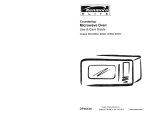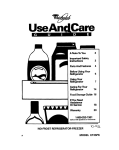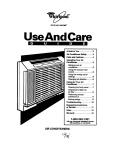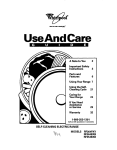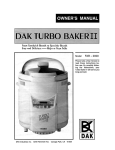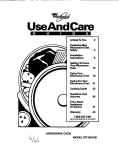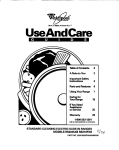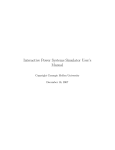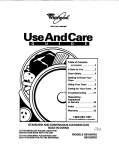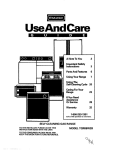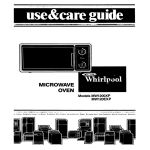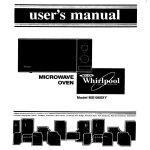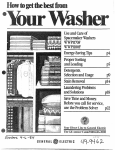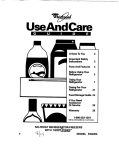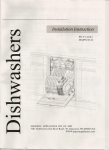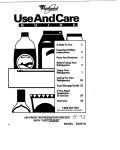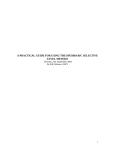Download Whirlpool MT0060XB User's Manual
Transcript
A Note To You 2 Understanding Microwave Oven safety 3 Precautions To Avoid Possible Exposure To Excessive Microwave Energy 5 Installation Instructions 8 Gettin -To Know I# EL ‘wwave 10 Using Your Microwave Oven 13 Caring For Your Microwave Oven 16 Cooking Guide 17 Questions And 21 AIISWWS If You Need g$-v~ 22 Warranty 24 1400-253-1301 Call us with questions MICROWAVE or comments. %d OVEN MODEL MT0060XB -- A Note To You Thank you for buying a Whirlpool@ appliance. You have purchased a quality, world-class home appliance. Years of engineering experience have gone into its manufacturing. To ensure that you will enjoy many years of trouble-free operation, we have developed this Use and Care Guide. It is full of valuable information on how to operate and maintain your appliance properly and safely. Please read it carefully. Also, please complete and mail the Ownership Registration Card provided with your appliance. This will help us not-Q you about any new information on your appliance. Your safety is important to us. This guide contains safety symbols and statements. Please pay special attention to these symbols and follow any instructions given. Here is a brief explanation of the use of each symbol. This symbol will help alert you to such dangers as personal injury burns fire 1 and electrical shock. ’ ’ This symbol will help you avoid actions 1 Our Consumer Assistance Center is toll-free, 24 hours a day. 11 (scratches, dents, etc.) and damage to number, l-800-253-1 301, If you ever have a question concerning your appliance’s operation, or if you need service, first see “If You Need Assistance Or Service” on page 22. If you need further help, feel free to call our Consumer Assistance Center. When calling, you will need to know your appliance’s complete model number and serial number. You can find this information on the model and serial number plate (see diagram on page 12). For your convenience, we have included a handy place below for you to record these numbers, the purchase date from the sales slip and your dealer’s name and telephone number. Keep this book and the sales slip together in a safe place for future reference. Model Number Dealer Name Serial Number Dealer Phone Purchase Date 2 Understanding Oven Safety IMPORTANT SAFEl=Y Microwave INSTRUCTIONS Microwave ovens have been thoroughly tested for safe and efficient operation. However, as with any appliance, there are special installation and safety precautions which must be followed to ensure safe and satisfactory operation and prevent damage to the unit. To reduce the risk of burns, fire, electrical shock, injury to persons, exposure to excessive microwave energy, or damage when using the microwave oven, follow basic precautions, including the following: l l l l l l l l l Read all instructions before using the microwave oven. Read and follow the specific “PRECAUTIONS TO AVOID POSSIBLE EXPOSURE TO EXCESSIVE MICROWAVE ENERGY” found on page 5. This appliance must be grounded. Connect only to properly grounded outlet. See “GROUNDING INSTRUCTIONS found on page 9. Install or locate this appliance only in accordance with the provided Installation Instructions found on page 8. Some products such as whole eggs in the shell and sealed containers-for example, closed glass jars-could explode and should not be heated in this oven. Do not heat, store or use flammable materials in or near the oven. Fumes could create a fire hazard or explosion. Use this appliance only for its intended use as described in this manual. Do not use corrosive chemicals or vapors in this appliance. This type of oven is specifically designed to heat or cook food. It is not designed for industrial or laboratory use. As with any appliance, close supervision is necessary when used by children. Do not operate this appliance if it has a damaged cord or plug, if it is not working properly, or if it has been damaged or dropped. Electrical shock, fire or other hazards could result. l This appliance should be serviced only by qualified service personnel. Call an authorized Whirlpool@ service company for examination, repair or adjustment. . Do not cover or block any opening on the appliance. Fire could result. l Do not store or use this appliance outdoors. Do not use this product near water-for example, near a kitchen sink, in a wet basement, or near a swimming pool, and the like. l Do not immerse cord or plug in water. l Keep cord away from heated surfaces. l Do not let cord hang over edge of table or counter. l See door surface and interior cleaning instructions on page 16. l To reduce the risk of fire in the oven cavity: -Do not overcook food. Carefully attend appliance if paper, plastic, or other combustible materials are placed inside the oven to facilitate cooking. Paper could char or burn, and some plastics could mett if used when heating foods. -Do not deep fry in oven. Microwavable utensils are not suitable and it is difficult to maintain appropriate deep frying temperatures. continued on next page 3 To reduce the risk of fire in the oven cavity (continued): - Test dinnerware or cookware before using. To test a dish for safe use, put it into the oven with a cup of water beside it. Cook at 100% Cook Power for one minute. If the dish gets hot and water stays cool, do not use it. Some dishes (melamine, some ceramic dinnerware, etc.) absorb microwave energy, becoming too hot to handle and slowing cooking times. Cooking in metal containers not designed for microwave use can damage the oven, as can containers with hidden metal (twist-ties, foil lining, staples, metallic glaze or trim). - Remove wire twist-ties from paper or plastic bags before placing bag in oven. -If materials inside the oven shoukl ignite, keep oven door closed, turn oven off, and disconnect the power cord or shut off power at the fuse or circuit breaker panel. 4 l -Do not use the cavity for storage purposes. Do not leave paper products, cooking utensils, or food in the cavity when not in use. -Do not operate any heating or cooking appliance beneath this appliance. -Do not mount unit over or near any portion of a heating or cooking appliance. -Do not mount over a sink. -Do not store anything directly on top of the appliance when appliance is in operation. Read and follow “Operating safety precautions” starting on page 6. 1. A short power-supply cord is provided to reduce the risks resutting from becoming entangled in or tripping over a longer cord. 2. Longer cord sets or extension cords are available and may be used if care is exercised in their use. 3. If a long cord or extension cord is used temporarily, (a) the marked electrical rating of the cord set or extension cord shouM be at least as great as the electriial rating of the appliance, (b) the extension cord must be a grounding-type, 3-wire cord that has a 3-blade grounding plug and a 3-slot receptacle that will accept the plug on the appliance, and (c) the longer cord should be arranged so that it will not drape over the countertop or tabletop where it can be pulled on by children or tripped over accidentally. 4. A qualified electrician must install a property grounded and polarized 3-prong receptacle near the appliance. - SAVE THESE INSTRUCTIONS - 1PRECAUTIONS TOAVOIDPOSSIBLE1 EXPOSURE TOEXCESSIVE MICROWAVEENERGY... Do not attempt to operate this oven with the door open since open-door operation can result in harmful exposure to microwave energy. It is important not to defeat or tamper with the safety interlocks. Do not place any object between the oven front face and the door or allow soil or cleaner residue to accumulate on sealing surfaces. Do not operate the oven if it is damaged. It is particularly important that the oven door close orooerlv and that there is no damage to the’: * (1) Door (bent), (2) Hinges and latches (broken or loosened), (3) Door seals and sealing surfaces. Do not operate the microwave oven if the door window is broken. The microwave oven should be checked for microwave leakage by qualified service oersonnel after a reDair is made. The oven should not be adjusted or repaired by anyone except properly qualified service personnel. Do not operate the microwave oven with the outer cabinet removed. 5 Operating safety precautions To reduce the risk of burns, fire, electrical shock, injury to persons, or damage when using the microwave oven, follow the precautions on pages 6-7. Never lean on the door or allow a child to swing on it when the door is open. Injury could result. Never cook or reheat a whole egg Inside the shell. Steam buildup in whole eggs may cause them to burst and burn you, and possibly damage the oven. Slice hard-boiled eggs before heating. In rare instances, poached eggs have been known to explode. Cover poached eggs and allow a standing time of one minute before cutting into them. Use hot pads. Microwave energy does not heat containers, but the hot food does. Stir before heating For best results, stir any liquid several times before heating or reheating. Liquids heated in certain containers (especially cylindrical containers) may become overheated. The liquid may splash out with a loud noise during or after heating or when adding ingredients (coffee, etc.) resulting in harm to the oven and possible personal injury. 6 Do not overcook potatoes. Fire could result. At the end of the recommended cooking time, potatoes should be slightly firm because they will continue cooking during standing time. After microwaving, wrap potatoes in foil and set aside for 5 minutes. They will finish cooking while standing. Do not start a microwave oven when il is empty. Product life may be shortened. If you practice programming the oven, put a container of water in the oven. Do not use newspaper or other printed paper in the oven. Fire could result. Do not dry flowers, fruit, herbs, wood, paper, gourds or clothes in the oven. Fire could result. Do not operate in the microwave mode unless the glass turntable is securely in place and can rotate freely. The turntable can rotate in either direction. Make sure the turntable is correct-side up in oven. Carefully place cookware on turntable to avoid possible breakage. Handle turntable with care when removing from oven to avoid possible breakage. If turntable cracks or breaks, contact your Whirlpool dealer for a replacement. When you use a browning dish, the browning dish bottom must be at least %6 inch above the turntable. Follow directions supplied with browning dish. General information Fuse box Do not try to melt paraffin wax in the oven. Paraffin wax will not melt in a microwave oven because it allows microwaves to pass through it. If your electric power line or outlet voltage is less than 110 volts, cooking times may be longer. Have a qualified electrician check your electrical system. 7 lnstalkrtion Instructions Before you begin operating the oven, carefully read the following instructions. Fire, Electrical Shock, Excessive Exposure To Microwave Energy, Personal Injury and Product Damage Hazard .Do not block the exhaust vents or rear air intake openings. Allow a few inches of space at back of oven where intake openings are located. Blocking the air intake openings and exhaust vents could cause damage to the oven and poor cooking results. Make sure the microwave oven legs are in place to ensure proper airflow. l Do not install the oven next to or over a heat source (for example, a cooktop or range). Also, do not install oven in any area where excessive heat and steam are generated. This could cause a fire, electrical shock, excessive exposure to microwave energy, other personal injury or damage to the outside of the cabinet. 1. Empty the microwave oven and clean inside it with a soft, damp cloth. Check for damage such as misaligned door, damage around the door, or dents inside the oven or on the exterior. If there is any damage, do not operate the unit until it has been checked by an authorized Whirlpoole service technician and any repairs made. Under-the-counter 2. Put the oven on a cart, counter, table, or shelf that is strong enough to hold the oven and the food and utensils you put in it. (The control side of the unit is the heavy side. Use care when handling.) The weight of the oven is approximately 26 Ibs (12.6 kg). The microwave oven should be at a temperature above 50°F (10°C) for proper operation. Power sup lY co d Exhaust vents A (on bottom in front) 8 Aiiintake openings kit You can fasten your microwave oven onto a wall or under a cabinet by using Kit No. 4376401. This kii is available from your Whirlpool Dealer. If your dealer does not stock the kit, it can be ordered, by kit part number, by writing to: Whirlpool Corporation Attention: Customer Service Dept. 1900 Whirlpool Drive LaPorte, IN 46350 Exhaust vents (on side) 3.Electrical requirements Observe all governing codes and ordinances. A 120 Volt, 60 Hz, AC only, 15 amp fused electrical supply is required. (Time-delay fuse is recommended.) It is recommended that a separate circuit serving only this appliance be provided. &GROUNDING INSTRUCTIONS Electrical Shock Hazard Improper use of the grounding plug can result in a risk of electrical shock. DO NOT, UNDER ANY CIRCUMSTANCES, REMOVE THE POWER SUPPLY CORD GROUNDING PRONG. 5. For your personal safety, this appliance must be grounded. In the event of an electriil short circuit, grounding reduces the risk of electrical shock by providing an escape wire for the electric current. This appliance is equipped with a polarized 3-prong grounding plug. It must be plugged into a correctly polarized mating 3-prong grounding type wall receptacle, property installed and grounded in accordance with the National Electrical Code and local codes and ordinances. If a mating wall receptacle is not available or if you are not sure if the wall receptacle is properly grounded and polarized, have it checked by a qualified electrician. It is the personal responsibility and obligation of the customer to have a properly grounded and correctly polarized 3-prong wall receptacle installed by a qualified electrician. Consult a qualified electrician if the grounding instructions are not completely understood, or if doubt exists as to whether the appliance is properly grounded. It is not recommended to use an extension cord with your microwave oven, but if you find it necessary to do so temporarily (until a properly grounded and polarized, 3-prong recep tacle is installed), use only a heavy duty, UL listed, 3-wire grounding type extension cord containing three 16-gauge (minimum) copper wires. It must not be l&prong grounding type wall receptacle &prong grounding longer than 10 feet (cords longer than 10 feet may affect the cooking performance of your microwave oven). The plug on the extension cord must fii into a 3-prong grounding type wall receptacle (as shown on this page) and the receptacle end of the extension cord must accept the 3-prong grounding plug of the microwave oven. To test the oven, plug it into the proper electriial outlet. Put about one cup (250 ml) of cold water in a glass container in the oven. Close the door. Make sure it latches. Follow the directions on page 13 to set the oven to cook for 2 minutes. When the time is up, the water should be heated. 7. This microwave oven is designed for use in the household only and must not be used for commercial purposes. Do not remove the door, control panel or cabinet at any time. The unit is equipped with high voltage and should be serviced by an authorized Whirlpool@ service technician. - SAVE THESE INSTRUCTIONS 9 Getting To Know Your Microwave Oven This section discusses the concepts behind microwave cooking and introduces you to the basics you need to know to operate your microwave oven. Please read this information before use. In This Section Page How microwave cooking works ......I0 How microwave cooking Page Microwave oven features ............. .... 12 works Magnetron Microwave ovens are safe. Microwave energy is not hot. It causes food to make its own heat, and it’s this heat that cooks the food. Microwaves are like TV waves or light waves. You cannot see them, but you can see what they do. 10 Oven\ cavity A magnetron in the microwave oven produces microwaves. The microwaves move into the oven where they contact food as it turns on the turntable. Glass turntable Metei floor The glass turntable of your microwave oven lets microwaves pass through. Then they bounce off a metal floor, back through the glass turntable, and are absorbed by the food. Microwaves may not reach the center of a roast. The heat spreads to the center from the outer, cooked areas just as in conventional cooking. This is one of the reasons for letting some foods (for example, roasts or baked potatoes) stand for a while after cooking, or for stirring some foods during the cooking time. The microwaves disturb water molecules in the food. As the molecules bounce around bumping into each other, heat is made, like rubbing your hands together. This is the heat that does the cooking. Radio Microwaves pass through most glass, paper and plastics without heating them so food absorbs the energy. Microwaves bounce off metal pans so food does not absorb the energy. interference Operation of the microwave oven may cause interference to your radio, TV or similar equipment. When there is interference, it may be reduced or eliminated by taking the following measures: l Clean door and sealing surfaces of the oven. l Adjust the receiving antenna of radio or television. l Move the receiver away from the microwave oven. l Plug the microwave oven into a different outlet so that the microwave oven and receiver are on different branch circuits. 11 Microwave oven features Your microwave oven is designed to make your cooking experience as enjoyable and productive as possible. To get you up and running quickly, the following is a list of the oven’s basic features: 1. OneTouch Door Open Button. Push to open door. 2. Door Safety Lock System. The oven will not operate unless the door is securely closed. 3. Window with Metal Shield. Shield prevents microwaves from escaping. It is designed as a screen to allow you to view food as it cooks. 4. Glass Turntable. This turntable turns food as it cooks for more even cooking. It must be in the oven during operation for best cooking results. See pages 7, 11 and 16 for more details. 12 5. Turntable Support (under turntable). 6. Timer Knob. Use this knob to set cook or defrost time. See page 14 for more information. 7. Cook Power Select Knob. Use this knob to set the microwave oven to cook or to defrost. See pages 13 and 14 for more information. 8. Llght. Automatically turns on when door is opened or when oven is operating. 9. Model and Serial Number Plate. Using Your Microwave This section gives you instructions instructions carefully. In This for operating each microwave function. Please read these Section Page Defrosting tips .......... .......... .............. 15 Stopping the oven ............... ............. 15 Page Getting the best cooking results ..... 13 Cooking .......... .. ................................. 13 Defrosting ..... .......................... ........... 14 Getting l l Oven the best cooking Although a new ratlng method’ rates this oven at 625 watts, you may use a reliable cookbook and recipes developed for microwave ovens previously rated at 500-550 watts. ALWAYS cook food for the minimum recommended cooking time. Then check for doneness to avoid overcooking the food. l results Stir, turn over or rearrange food being cooked about halfway through the cook time for most even doneness with all recipes. l If a glass cover is not available, use wax paper, paper towels or microwaveapproved plastic warp. Turn back a corner to vent steam during cooking. ‘IEC-705 Test Procedure. The IEC-705 Test Procedure is an intemaiionally recognized method of rating microwave wattage output and does not represent an actual change to output power or cooking performance. Cooking Recipes from many microwave oven cookbooks, as well as from other books and magazines, use Cook Power settings other than 100%. Because your microwave oven only cooks at 1OO%, please use the “Heating or reheating chart” on page 17 and the “Microwave cooking chart” on page 18 as guides for your cooking. 1. Put food in oven and close door. 2. Turn Cook Power Select Knob to COOK. continued on next page 13 -_ , - 3. Turn Timer Knob to set cooking time. Turn knob clockwise to increase time. Turn knob counterclockwise to decrease time. NOTE: For accurate timing, it is best to always turn knob past the time you want, then back to desired time. To set Timer Knob for less than one minute, turn knob past one minute, then to desired time. 4. After cooking, open door. A bell-type tone will sound when cooking is over. Defrosting Use the DEFROST setting to thaw frozen food before cooking. This setting cooks at 40% of full power for the desired defrosting time. 1. Put frozen food in oven and close door. 2. Turn Cook Power Select Knob to DEFROST. 3. Turn Timer Knob to set defrosting time. Turn knob clockwise to increase time. Turn knob counterclockwise to decrease time. NOTE: For accurate timing, it is best to always turn knob past the time you want, then back to desired time. To set Timer Knob for less than one minute, turn knob past one minute, then to desired time. 4. After defrosting, open door. A bell-type tone will sound when defrosting is over. 14 - Defrosting l l l You will get best results when food to be thawed is a minimum of 0°F (taken directly from a freezer). If the food is stored outside the freezer for more than 20 minutes, and for defrosting ready-made food, let stand after defrosting. The shape of the package alters the defrosting time. Shallow rectangular packets defrost more quickfy than a deep block. Stopping l tips l l l Separate pieces as they begin to defrost. Separated pieces defrost more easily. You can use small pieces of aluminum foil to shieM foods like chicken wings, leg tips, and fish tails, but the foil must not touch the side of the oven. Foil can damage the oven lining. Shield areas of food with small pieces of foil if they start to become warm. the oven Turn the Timer Knob counterclockwise to OFF. OR l Open the oven door. Opening the oven door stops the oven so you can stir, turn, rearrange or add ingredients to the food. Close the oven door to complete cooking and the oven will automatically continue to operate. If you remove the food, set the Timer Knob to OFF before closing the oven door so oven will not operate. 15 Caring For Your Microwave Oven To make sure your microwave oven looks good and works well for a long time, you should maintain it properly. For proper care, please follow these instructions carefully. Product Damage Hazard Wipe often with warm, sudsy water and a sponge or paper towel. You can remove the glass turntable to clean the oven cavity floor; however, this oven is designed to operate with the turntable in place. Do not operate the microwave oven when turntable is removed for cleaning. See page 7 for further information about the turntable. Abrasive cleansers, steel-wool pads, gritty wash cloths, etc., could damage the control panel, and the interior and exterior oven surfaces. Use a sponge with a mild detergent or a paper towel with spray glass cleaner. Apply spray glass cleaner to paper towel; do not spray directly on oven. Turntable support To clean turntable and turntable support, wash in mild, sudsy water; for heavily soiled areas use a mild cleanser and scouring sponge. The turntable and turntable support are dishwasher-safe. For stubborn soil, boil a cup of water in the oven for 2 or 3 minutes. Steam will soften the soil. To get rid of odors inside the oven, boil a cup of water with lemon juice. Be sure to keep the areas clean where the door and oven frame touch when closed. Use only mikf, nonabrasive soaps or detergents applied with a sponge or paper towel when cleaning surfaces. Rinse well. 16 Cooking Heating Guide or reheating Times are approximate chart and may need to be adjusted to individual taste. SPECIAL IINSTRUCTIONS Place sliced meat on microwavable plate. Cover with plastic wrap: vent. NOTE: Gravy or sauce helps to keep meat iuicv. Place chicken pieces on microwavable Cover with plastic wrap; vent. Fish Fillet 5 % if$ : 4: plate. Place fish on microwavable plate. Cover with plastic wrap; vent. Place lasagna on microwavable Cover with plastic wrap; vent. plate. Cook covered in microwavable casserole: once halfway through cooking. stir Cook covered in microwavable casserole; once halfway through cooking. stir $ 1 Reheat filling and bun separately. Cook filling covered in microwavable casserole; stir once. Heat bun as discussed under “Sandwich Roll or Bun” below. sandwich casserole; stir Cook covered in microwavable casserole: once halfway through cooking. stir covered in microwavable 4 cups Baked Beans 1 cup Ravioli or Pasta in Sauce 1 cup 4 CUDS “:’ 0 v g;. m Wrap in paper towel and place on roast rack. roll Vegetables 1 1 cup 4 cups soup 1 serving (8 02) once halfway through cooking. Cook covered in microwavable halfway through cooking. bowl; stir once 17 Microwave cooking Times are approximate chart and may need to be adjusted to individual taste. - FOOD SPECIAL INSTRUCTIONS Ground Beef (1 lb) Stir every 2 minutes. Add sauce or casserole ingredients and finish. To cook frozen block, microwave 9 to 12 minutes breaking up and stirring crumbled (for casseroles or soup) Meatballs (1 lb) Bacon (4 slices, ‘4 lb) Arrange in single layer. Rotate dish l/4 turn after half of time. 5 Microwave until fish flakes easily. Let 1 stand 3 minutes before serving. E Chicken Pieces di! oven and microwave for half of total time. Scrape portions from outside to Rice, Regular Long Grain (1 cup) Carrot (1 lb) Broccoli, fresh (1 lb) Onions, fresh (l/z lb) Peas, Green fresh (1 lb) frozen (10 02) 18 Add & 1 lV2 cups hot tap water and n salt, stir after 7 minutes. covered 5 minutes before Add 2 to 4 tablesDoons of water. Rotate dish -‘I4 after hatf 01‘time. ’ Cut carrots into slices l/z inch thick. Add 114cup water. Add % cup water. Use small, whole onions. Add ‘14cup water. Add ‘13cup water. - FOOD COVER SPECIAL INSTRUCTIONS Wrap Rinse and pat dry. Prick with fork several times. Arrange in circular pattern on paper-lined oven bottom, equal distance apart. Turn over after half of time. Let stand 5 minutes before serving. Potatoes (2) (6 oz each) No Sauces melted butler sauces, clarified Microwave butter (1 l/2 cups) Microwave Amount l cooking tips of food Covering The more food you want to prepare, the longer it takes. A rule of thumb is that a double amount of food requires almost double the time. If one potato takes four minutes to cook, you need about seven minutes to cook two potatoes. Starting l temperature of food The lower the temperature of the food being put into the microwave oven, the longer it takes to cook. Food at room temperature will be reheated more quickly than food at refrigerator temperature. Composition l l l Releasing l turning foods Stirring and turning foods distributes heat quickly to the center of the dish and avoids overcooking at the outer edges of the food. pressure to pass in foods Several foods (for example: baked potatoes, sausages, egg yolks, and some fruits) are tightly covered by a skin or membrane. This can cause the food to burst from steam building up in them during cooking. To relieve the pressure and to prevent bursting, prick these foods with a fork, cocktail pick or toothpick. Using l standing time Always allow food to stand for a while after cooking. Standing time after defrosting, cooking, or reheating always improves the result since the temperature will then be evenly distributed throughout the food. l Smaller pieces of food will cook faster than larger pieces and same-shaped pieces of food cook more evenly than irregularly shaped foods. With unevenly shaped foods, the thinner parts will cook faster than the thicker areas. Place the thinner parts of chicken wings and legs in the center of the dish. Stirring, l All coverings that allow microwaves through are suitable. of food heated faster than food containing a lot of water. Fat and sugar will also reach a higher temperature than water in the cooking process. The more dense the food, the longer it takes to heat. “Very dense” food like meat takes longer to reheat than lighter, more porous food like sponge cakes. food Cover food to: l Reduce splattering l Shorten cooking times l Retain food moisture Food with a lot of fat and sugar will be Size and shape l butter just to melt. For clarified butter, bring to boil, then let stand until layers separate. Pour off and use clear top layer. l When cooking in a microwave oven, food continues to cook even when the microwave energy is turned off. Food is no longer cooked by microwaves, but it is still being cooked by the high heat left over from the microwave oven. The length of the standing time depends on the volume and density of the food. Sometimes it can be as short as the time it takes you to remove the food from the oven and take it to the serving table. However, with larger, denser food, the standing time may be as long as 10 minutes. 19 -.- Arranging food For best results, distribute food evenly on the plate. You can do this in several ways: l If you are cooking several items of the same food, such as baked potatoes, place them in a ring pattern for uniform cooking. l l l l l l l When cooking foods of uneven shapes or thickness, place the smaller or thinner area of the food towards the center of the dish where it will be heated last. Arrange uneven foods, such as fish, in the oven with the tails to the center. If you are saving a meal in the refrigerator or “plating” a meal for reheating, arrange the thicker, denser foods to the outside of the plate and the thinner or less dense foods in the middle. Place thin slices of meat on top of each other or interlace them. Place thicker slices of meat, such as meat loaf and sausages, close to each other. Reheat gravy or sauce in a separate container. When you cook or reheat whole fish, score the skin -this l l prevents cracking. Shield the tail and head of whole fish with small pieces of foil to prevent overcooking and ensure the foil does not touch the sides of the oven. Do not let food or container touch the top or sides of the oven. This will prevent possible arcing. Using aluminum foil Metal containers usually shoukf not be used in a microwave oven. There are, however, some exceptions. If you have purchased food which is prepackaged in an aluminum foil container, then refer to the instructions on the package. It is possible to use disposable containers, but it generally takes longer and the final result will not be as good as if food were placed in plastic or paper containers. 20 If you use aluminum containers without package instructions, follow these guidelines: l Place container in a glass bowl and add some water so that it covers the bottom of the container, not more than 9’4inch high. This ensures even heating of the container bottom. l Always remove the lid to avoid damage to the oven. l Use only undamaged containers. l Do not use containers taller than Vi”. l Container must be half filled. l To avoid sparking, there must be a minimum l/4’ between the aluminum container and the walls of the oven and also between two aluminum containers. l Always place container on turntable. l Thickness of the food layer must be greater than thickness of the aluminum. l Reheating food in aluminum foil containers usually takes up to double the time compared to reheating in plastic, glass, china, or paper containers. The time when food is ready will vary a great deal. l Let food stand for 2-3 minutes after heating so that heat is spread evenly throughout container. Cooking you should not do in your microwave oven l l Do not do canning of foods in the oven. Closed glass jars may explode, resulting in damage to the oven or possible personal injury. Do not use the oven to sterilize objects (baby bottles, etc.). It is difficult to maintain the high temperature required for safe sterilization. - Questions And Answers QUESTIONS ANSWERS Can I operate my microwave oven without the turntable or turn the turntable over to accommodate a large dish? No. If you remove or turn over the turntable, you will get poor cooking results. Dishes used in your oven must fit on the turntable. Can I use a rack in my microwave oven so that I may reheat or cook on two levels at a time? You can use a rack only if rack is supplied with your microwave oven. Use of any rack not supplied with the microwave oven can result in poor cooking performance and/or arcing. Usable metal includes aluminum foil for shielding (use small, flat pieces), small skewers and shallow foil trays (if tray is % inch deep and filled with food to absorb microwave energy). Never allow metal to touch walls or door. (For more information, see page 20.) Yes. The turntable rotates clockwise or counterclockwise, depending on the rotation of the motor when the cooking cycle begins. This appearance is normal and does not affect the operation of your oven. You hear the sound of the transformer when the magnetron tube cycles on. As the food becomes hot it will conduct the heat to the dish. Be prepared to use hot pads to remove food after cooking. Can I use either metal or aluminum pans in my microwave oven? Is it normal for the turntable to turn in either direction? Sometimes the door of my microwave oven appears wavy. Is this normal? What are the humming noises that I hear when my microwave oven is operating? Why does the dish become hot when I microwave food in it? I thought that this should not happen. What does “standing time” mean? Can I pop popcorn in my microwave oven? How do I get the best results? Why does steam come out of the air exhaust vent? “Standing time” means that food should be taken out of the oven and covered for additional time after cooking. This process allows the cooking to finish, saves energy and frees the oven for another purpose. Yes. Pop packaged microwave popcorn following manufacturer’s guidelines. Do not use regular paper bags. Use the “listening test” by stopping the oven as soon as the popping slows to a “pop” every one or two seconds. Do not try to repop unpopped kernels. You can also use special microwave poppers. When using a popper, be sure to follow manufacturer’s directions. Do not pop popcorn in glass utensils. Use care when popping 3.5 oz bags of popcorn; because of large size of bag and small size of oven cavity, bag can become stuck between turntable and oven wall. Steam is normally produced during cooking. The microwave oven has been designed to vent this steam out the bottom and side vents. 21 If You Need Assistance Or Service This section is designed to help you save the cost of a service call. Part 1 of this section outlines possible problems, their causes, and actions you can take to solve each problem. Parts 2 and 3 tell you what to do if you still need assistance or service. When calling our Consumer Assistance Center for help or calling for service, please provide a detailed description of the problem, your appliance’s complete model and serial numbers and the purchase date. (See page 2.) This information will help us respond properly to your request. 1. Before calling for assistance ... Performance problems often result from little things you can find and fix without tools of any kind. Please check the chart below for problems you can fix. It could save you the cost of a service call. PROBLEM Nothing will operate POSSIBLE CAUSE SOLUTION The power supply cord is not plugged into a live circuit with the proper voltage. Plug power supply cord into a live circuit with the proper voltage. (See pages 7 and 9.) A household fuse has blown or a circuit breaker has tripped. Replace household fuse or reset circuit breaker. The electrii company has experienced a power failure. Check electric company for a power failure. The microwave oven will not run The door is not firmly closed and latched. Firmly close and latch door. You did not follow directions exactly. Check instructions are operating . Turntable will not turn Turntable place. Make sure turntable is correct-side up and is sitting securely on center shaft. The fan -ms to be running slower than usual Microwave cooking times seem too long 22 is not correctly in for the function you Support is not operating correctly. Remove turntable and restart oven. If turntable support does not move, call an authorized Whirlpool service technician for repair. Cooking without the turntable can give you poor results. The oven has been stored in a cold area. The fan will run slower until the oven warms up to normal room temperature. The electric supply to your home or wall outlets is low or lower than normal. Your electric company can tell you if the line voltage is low. Your electrician or service technician can tell you if the outlet voltage is low. The Cook Power Select Knob is not at the correct setting. Turn knob to COOK for 100% Cook Power. There is not enough cooking time for the amount of food being cooked. Allow for more time when cooking more food at one time. 2. If you need assistance ... Call Whirlpool Consumer Assistance Center telephone number. Dial toll-free from anywhere in the U.S.A.: 1-800-253-1301 and talk with one of our trained consultants. The consultant can instruct you in how to obtain satisfactory operation from your appliance or, if service is necessary, recommend a qualified service company in your area. If you prefer, write to: Mr. William Clark Consumer Assistance Representative Whirlpool Corporation 2000 N State Route 63 Benton Harbor, Ml 49022-2692 Please include a daytime phone number in your correspondence. 3. If you need service 4. If you are not satisfied how the problem was solved . . . l l l with Contact the Major Appliance Consumer Action Panel (MACAP). MACAP is a group of independent consumer experts that voices consumer views at the highest levels of the major appliance industry. Contact MACAP only when the dealer, authorized servicer and Whirlpool have failed to resolve your problem. Major Appliance Consumer Action Panel 20 North Wacker Driie Chicago, IL 60606 MACAP will in turn inform us of your action. . .. Whirlpool has a nationwide network of authoSE!!!: rized WhirlpooP service 79 companies. Whirlpool service technicians are trained to fulfill the product warranty and provide after-warranty service, anywhere in the United States. To locate the authorized Whirlpool service company in your area, call our Consumer Assistance Center telephone number (see Step 2) or look in your telephone directory Yellow Pages under: ‘APPLIANCMIOUSEHOLD MAJOR, SERVICE L REPAIR - see whldpool Apphmes or Aulhdzd Whtw Setvl~ (Gmqlb:xYi! !3mvh Co.) ‘WASHINO DRYERS, YACHINES L SERVlCE L REPAM - SW: WhIrlpool Appliances or Aulhorlzed WhIrlpool .Smvka (ExMp*rrn solvka Co.) 23 WHIRLPOOL” Microwave Oven Warranty LENGTH OF WARRANTY 1 WHIRLPOOL WILL PAY FOR FULL ONE-YEAR WARRANTY From Date of Purchase FSP@ replacement parts and repair labor to correct defects in materials or workmanship. Service must be Drovided bv an authorized Whirlpool@ service companv. LIMITED FOUR-YEAR WARRANTY Second Through Fiih Year From Date of Purchase FSP replacement magnetron tube on microwave ovens if defective in materials or workmanship. WHIRLPOOL WILL NOT PAY FOR A. Service calls to: 1. Correct the installation of your microwave oven. 2. Instruct you how to use your microwave oven. 3. Replace house fuses or correct house wiring. 4. Replace owner accessible light bulbs. B. Repairs when your microwave oven is used in other than normal, single-family household use. C. Pickup and delivery. Your microwave oven is designed to be repaired in the home. D. Damage to your microwave oven caused by accident, misuse, fire, flood, acts of God or use of products not approved by Whirlpool. E. Any labor costs during limited warranty. F. Repairs to parts or systems caused by unauthorized appliance. modifications made to the WHIRLPOOL CORPORATION SHALL NOT BE LIABLE FOR INCIDENTAL OR CONSEQUENTIAL DAMAGES. Some states do not allow the exclusion or limitation of incidental or consequential damages, so this limitation or exclusion may not apply to you. This warranty gives you specific legal rights, and you may also have other rights which vary from state to state. Outside the United States, a different warranty may apply. For details, please contact your authorized Whirlpool distributor or military exchange. If you need service, first see the “If You Need Assistance or Service” section of this book. After checking “If You Need Assistance or Service,” additional help can be found by calling our Consumer Assistance Center telephone number, 1-880-253-1381, from anywhere in the U.S.A. PART NO. 3874W500831/4358587 0 lee4 Whldpd CoIporallon Q Rcgldcred Trademark ol Whirlpool. USA. Prlnled in Korea
























